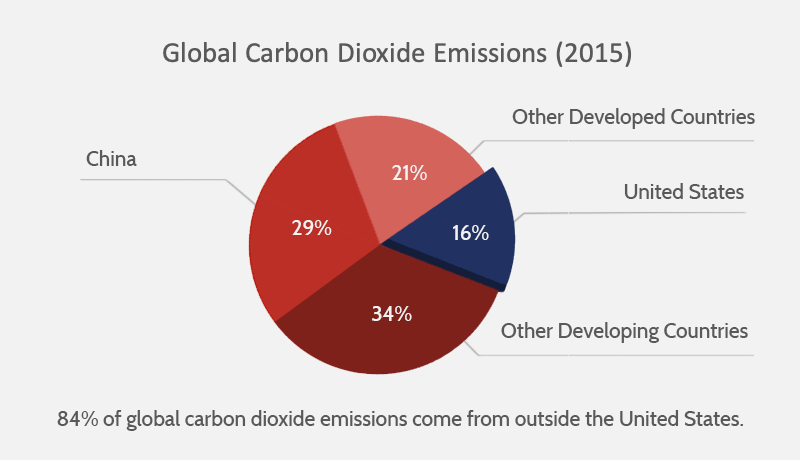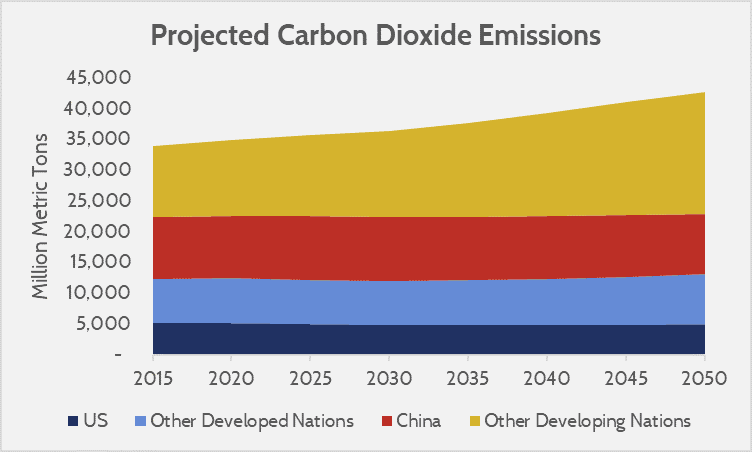Insight
May 20, 2019
Primer: No Country Can Fix Climate Change on Its Own
Summary
- The United States is the second largest emitter of greenhouse gases, but represents less than 15 percent of the global total.
- Climate change is a global problem that requires international action to make a significant impact, yet such cooperation has traditionally been hard to muster, as countries have been reluctant to accept disproportionate cuts to their own emissions or cuts that could imperil economic growth.
- Innovation to make low-carbon energy economically viable on an international level must be a central pillar of any successful climate change strategy.
The Global Problem
The global nature of climate change is a fundamental component of the climate change challenge, yet rarely plays the central role in policymaking. Instead, politicians’ climate proposals are invariably focused primarily on domestic policies. That focus is natural, since Congress has little reach beyond America’s shores on this issue, but it has created a misleading perception that domestic policies alone could have a meaningful impact on the future costs from climate change.
In fact, even the most dramatic domestic climate policy would have only a small impact on the problem. The United States has contributed the most to global warming historically, but the United States emits only a small share of current global emissions—about 16 percent of carbon dioxide and just over 14 percent of total greenhouse gasses—and that percentage is shrinking every year. Other nations, especially developing ones, are growing rapidly, using more energy—and therefore emitting more greenhouse gases.
Source: Energy Information Administration, International Energy Outlook (2017)
The reality of rising global emissions means that dramatic policies such as the Green New Deal would barely affect the climate outlook. Even if the United States’ domestic policies were to eliminate all of its emissions by 2050, global emissions would still rise, all else being equal.
The Challenge of Global Action
The solution to a global collective action problem requires global cooperation. Unfortunately, this cooperation has traditionally been hard to muster, and it is easy to see why. Western powers built their hegemony on industrialization and its accompanying carbon emissions. Still-developing nations are contributing the most to projected greenhouse gas emissions, and that includes the world’s largest emitter (China). Developing nations do not want to forgo the benefits of industrialization that Western powers have already reaped, but the idea that China and other rapidly growing nations would not have an equal burden is a non-starter for the United States. That dynamic contributed significantly to the ultimate failure of the Kyoto Protocol.
Attempts at a more inclusive treaty, a la the Paris Agreement, have failed to get enough concessions to reach any climate targets. Foreign powers, particularly rapidly growing ones such as China, are reticent to adopt policies that might constrain their growth and handicap their power—especially considering that some relationships (e.g. U.S.-China) are becoming increasingly adversarial.
Climate change is fundamentally a global collective-action problem: Each country has the incentive to let the others make the painful cuts while reaping the benefits at home of emitting greenhouse gases. Put another way, the domestic benefit of carbon-emitting activities outweighs the costs, since the costs are global. The problem is a classic “prisoners’ dilemma.”
Compounding the challenge is that much of the growth driving energy consumption is fundamentally good. Global poverty, and the troubles that come with it, have been on a sharp decline, thanks almost entirely to competitive markets fueled largely by carbon-intensive energy sources. A policy of constraining growth, as proponents of the “degrowth movement” advocate, is a veneer for an ugly philosophy that would deny many of the world’s poorest the opportunity for a better life.
The Solution to Climate Change Probably Doesn’t Exist Yet
To address climate change without constraining growth, and all the benefits growth brings, requires a source of energy that is clean, cheaper than fossil fuels, and deployable anywhere and at any time. As Bill Gates puts it, an “energy miracle” is needed. That miracle is probably going to come from innovative technology that doesn’t exist yet.
If a new energy source can be developed that fits the criteria of the above, the political calculus changes dramatically. Nations will adopt clean energy technology—not for a political purpose, but because it is economically beneficial. International agreements on climate policy would become much more achievable, as the costs of compliance would fall sharply.
Several technologies show significant promise. NetPower is a natural gas plant that replaces its reliance on water and steam to spin turbines with carbon dioxide in a closed system. NuScale hopes to upend the traditional economies of scale for nuclear power and miniaturize plants that can be mass produced and shipped wherever needed. Carbon Engineering aims to set up factories that will literally suck carbon dioxide out of the air and turn it into combustible fuel (allowing for engines that currently use fossil fuels to become carbon neutral). There are other exciting technologies under development, as well.
The importance of innovation is clear, but the United States has not focused on this area in its climate policies. Current policy is focused on incumbent technologies rather than the development of new ones. To wit: Over the next 10 years, the United States will expend more than $110 billion on tax breaks for energy (mostly wind and solar) yet will spend less than $80 billion on scientific research through the Department of Energy. These figures broadly indicate a policy that is inverted from its ideal and necessary focus.
A Climate Policy Is Not a Climate Strategy
Any serious climate proposal must connect the policy with the desired outcome. Combatting climate change requires a reduction in greenhouse gas emissions that exceeds what the United States alone can provide. As a result, when politicians promise domestic reductions in pollution, the potential benefits are marginal at best.
The United States needs a climate strategy that applies the nation’s finite resources in a way that has the greatest impact on the problem. Because climate change is a global issue requiring coordinated action among different countries with different interests, innovation to make low-carbon energy economically viable must be at the heart of an effective climate change strategy. A serious climate policy must have a plan both for how to reduce emissions at home and for how to ensure that developing nations can access enough low-carbon energy to enjoy the benefits of economic growth. Policies that are purely focused on expending resources domestically, and with no strategy for how developing nations, which cannot afford the expensive climate policies of the West, will adopt them, risk steering resources to a strategy that ultimately has no pathway to success.












